Corporate Net-Zero Pledges: The Bad and the Ugly
Also available in PDF here.
The Paris Agreement on Climate Change, adopted in 2015 and ratified or acceded to by 192 states and the European Union (EU), marked a historic turning point on global climate action. Achieving the agreement’s goal of limiting global warming to not more than 1.5 °C relative to the industrial era (1880-1900) will require a transformation of global energy systems, with the active participation and contribution of all actors in the economy. Many companies have pledged to reach net-zero direct and indirect greenhouse gas (GHG) emissions by 2050. This report analyzes such pledges by 35 companies across seven industries—oil and gas, mining, chemicals, utilities, cement, steel, and food processing—that jointly represent 64% of global GHG emissions on a direct emissions (scope 1) basis.

To examine how industry giants incorporate climate considerations into their business plans, this analysis considers companies that are ranked within the top ten of their sectors based on market capitalization. In addition, the analysis focused on companies that have publicly available net-zero pledges or other climate targets that provide insights into their future decarbonization plans.
Based on data from Climate Action 100+ (CA100+), Influence Map (IM), Transition Pathway Initiative (TPI), Science Based Targets Initiative (SBTi), and corporate sustainability reports from the selected companies, this analysis leveraged qualitative and quantitative methods to understand the quality of net-zero pledges and reports from these industry giants. Specifically, this report focuses on the following questions:
1. Does the company have short- and medium-term targets?
2. Are the targets based on absolute emissions or on emissions intensity?
3. Are the targets aligned with science-based climate goals?
4. Does the company’s net-zero target include scope 3 GHG emissions?
5. Does the company consider targets in planning for capital expenditures (CAPEX), use an internal carbon price, or both?
6. Does the company rely on carbon offsets, carbon capture and sequestration (CCS), or both?
7. Does the company’s governance structure incentivize climate action?
8. Does the company have a policy not to lobby against climate policy?
Does the Company Have Short- And Medium-Term Targets?
While 94% of the companies analyzed have set long-term targets extending over the next few decades, only 43% set short-term targets, which are vital to prompt immediate action necessary to reach the ambitious long-term targets.
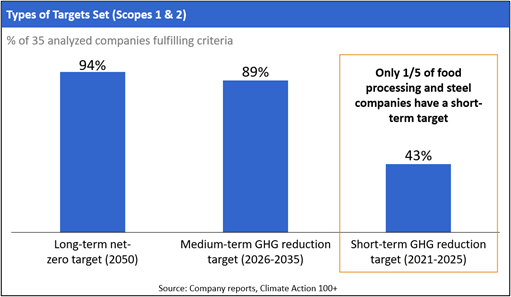
Are Targets Based on Absolute Emissions or on Emissions Intensity?
GHG reduction targets set by companies can be based on absolute emissions or on emissions intensity. An absolute target consists of a set number of metric tons of emissions, usually expressed in CO2-equivalent (CO2e) to account for CO2 as well as other GHGs. Often this number is indicated as a percentage of emissions relative to a selected base year. For example, a cement company analyzed set a 2030 goal to reduce its GHG emissions by 28% relative to its selected base year of 2007.
In turn, intensity-based targets measure metric tons of CO2e per unit of production. Another cement company pledged to reduce its emissions intensity to below 520 kg CO2e per metric ton of output by 2030. Intensity-based decarbonization goals are controversial, as they do not guarantee absolute emissions reductions. If a company’s emissions intensity decreases, but its production volume increases at a greater rate, its annual GHG emissions may still increase. Accordingly, absolute targets are preferable: a company that sets and achieves an absolute emissions target will shrink its carbon footprint, even if its production increases.
Of the analyzed companies, 37% use absolute emissions reduction targets, 37% using both absolute- and intensity-based targets, and 26% solely using an intensity target. Oil and gas companies are most-heavily reliant on intensity targets, with all assessed oil and gas companies using either only an intensity target or a blend of absolute- and intensity-based targets. The recipe for effective decarbonization is simple: use reduction methods that guarantee absolute emissions reductions.
Are the Targets Aligned with Science-Based Climate Goals?
From a climate perspective, the most important question of this analysis is whether the corporate emissions reduction targets are aligned with science-based targets.
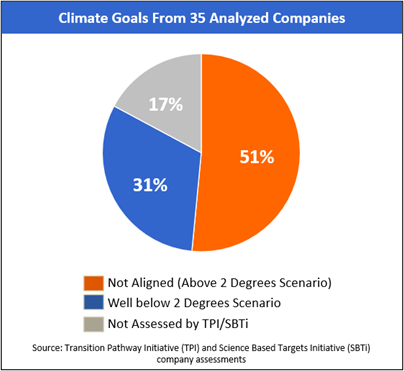
TPI’s and SBTi’s assessments of companies’ capabilities for transitioning to zero-carbon products and services are invaluable to analyze a company’s preparedness for a zero-carbon future. To make their assessments, TPI collaborates with FTSE Russel, which provides TPI with data related to climate change and corporate governance for TPI’s vast database of companies. SBTi, on the other hand, validates companies’ targets based on their science-based criteria. Factors integrated in their analysis include the inclusion of scope 1 and scope 2 emissions, base years and targets, progress to date, modeling method validity, and many more criteria.
Most companies for which TPI and SBTi had data were found not to be aligned with science-based targets.
Figure 4 provides a breakdown of each sector based on their alignment to certain global warming scenarios. The oil and gas industry and the mining industry are disproportionately unaligned to climate goals, with 8 out of 10 companies assessed unaligned with the below 2 degrees warming scenario. The cement and steel industries, in which GHG emissions are hard to abate, seem to have the potential to align with climate targets if they continue on their current trajectory.
The general misalignment to science-based targets is particularly concerning because any misalignment to them practically nullifies any existing net-zero pledge. Furthermore, the threshold this analysis set at 2 °C is already quite high, as the Paris Agreement targets a significantly lower 1.5 °C. Thus, if a company cannot even meet the 2 °C threshold set by TPI and SBTi, their operations must be significantly misaligned with the targets of the Paris Agreement. Indeed, 2 °C of warming would be devastating. Companies must rapidly decarbonize their operations and products in line with science-based thresholds.
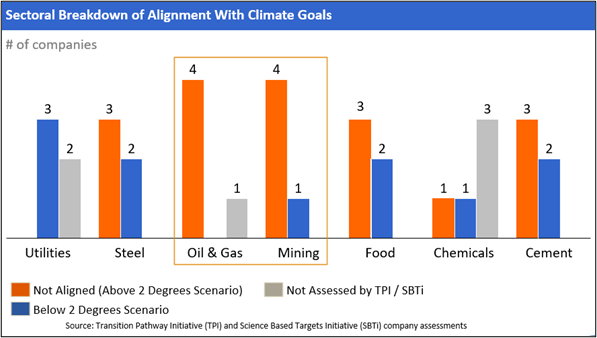
Does the Company’s Net-Zero Target Include Scope 3 GHG Emissions?
GHG accounting is crucial for companies to track and report on their GHG emissions and to monitor progress towards reduction targets. Three different scopes of emissions are typically used to classify the types of GHG emissions that result from various practices. Scope 1 emissions entail the reporting company’s direct emissions, which generally occur within its facilities or from its equipment. Scope 2 emissions are indirect emissions from purchased electricity, steam, heating, or cooling. Scope 3 emissions are broken down into 15 subcategories. Particularly relevant are categories 11 (use of sold products)—which entails, for example, the combustion of petroleum products produced by an oil company; category 6 (business travel); and category 4 (upstream transportation and distribution).
To understand the full picture of a company’s carbon footprint, it is critical that corporate sustainability reports include all three scopes and the relevant scope 3 subcategories. Figure 5 illustrates how critical scope 3 emissions are in the context of overall emissions by a company and its value chain, and the associated danger of misleading GHG accounting if scope 3 emissions are omitted—which they frequently are. For Shell, Rio Tinto, and McDonald’s, for instance, over 90% of their emissions occur in scope 3.

Many of the products of oil and gas companies are later combusted by consumers. Many of the products of mining companies are later smelted by downstream producers. And food processing companies source their products from the agriculture sector, which is plagued by land-use change and methane emissions. For these companies, more than 90% of life-cycle GHG emissions lie not within the company’s direct emissions (scope 1) or its purchased electricity (scope 2), but elsewhere in its value chain, whether upstream or downstream (scope 3).
Due to the importance of scope 3 for some sectors, its omission from reporting and target-setting frameworks is highly concerning. By omitting scope 3, a company fails to monitor and target the reduction of the bulk of its contributions to climate change.
Figure 6 shows the breakdown of scope 3 reporting by industry. Only 37% of the companies analyzed set scope 3 emissions reduction targets. The mining and oil and gas sectors have minimal target-setting on scope 3, despite the fact that their scope 3 emissions represent the vast majority of their life-cycle emissions.
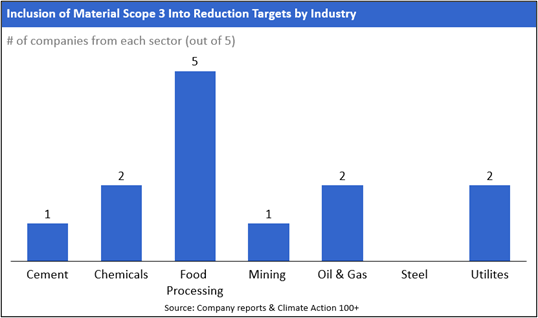
The takeaway is clear: companies must be required to report on all relevant scope 3 emissions categories so that policy makers, investors, and consumers have a full picture of companies’ contribution to climate change. To facilitate alignment with the Paris Agreement through harmonizing GHG accounting methods that enable accuracy, transparency, reliability, and comparability of emissions reporting, Coalition on Materials Emissions Transparency (COMET) is creating a harmonized methodology and attribution framework that brings together the main GHG accounting standards and disclosure platforms.
Does the Company Consider Reduction Targets in Planning for Capital Expenditures (CAPEX), Use an Internal Carbon Price, or Both?
Besides the three scopes of emissions, this research considered whether companies consider emissions reduction targets when planning for future capital expenditures (CAPEX). Based on data obtained from Climate Action 100+, figure 7 shows that only 17% of companies analyzed consider emissions reduction targets when deciding on CAPEX. This is particularly concerning because carbon-intensive CAPEX could lock companies in positions in which they are bound to emit large amounts of GHGs for several decades. On the flip-side, if a company prioritizes cutting its future GHG emissions through its CAPEX, for instance by integrating renewable energy into mining operations, it can decarbonize its operations without sacrificing the quality of its goods and services.

The companies that integrate CAPEX planning into GHG reduction commitments are led by the oil and gas companies in the sample. The remaining sectors, however, do not consider GHG reduction targets when they consider CAPEX, possibly locking them into more carbon-intensive futures when making CAPEX investments.
To incorporate the cost of carbon emissions into their business models, some companies adopt an internal carbon price. An internal carbon price creates an assumed cost per ton of CO2e emissions. In theory, this price represents the hidden risks and costs associated with the emissions of GHGs and helps companies forecast future costs in profit-and-loss statements, as well as encourage the development of low-carbon innovation within the company. A high internal carbon price disincentivizes investments in carbon-intensive CAPEX. This report finds that most companies lack an internal carbon price to begin with, and the companies that do use an internal carbon price often have a price far too low (or set too far in the future) to internalize the costs of emitting GHGs into the atmosphere. The average internal carbon price used by the companies analyzed is USD 41 per metric ton of CO2e, and the median value is USD 37.50 per metric ton of CO2e. In comparison, the EU’s Emissions Trading Scheme (EU ETS) carbon price has risen beyond USD 70 per metric ton of CO2e. The International Monetary Fund indicates that a global carbon price of roughly USD 75 per metric ton of CO2e is needed to catalyze significant emissions cuts.
Does the Company Rely on Carbon Offsets, Carbon Capture and Sequestration (CCS), or both?
Carbon offsets and CCS are often incorporated into business plans as alternatives to reducing emissions. The Intergovernmental Panel on Climate Change (IPCC) classifies carbon offsets as “activities, such as planting and protecting forests, [that] could provide carbon sequestration services that could be sold or traded.” The hope with offsets is that for each metric ton of CO2e emissions created by a company, the company could fund offset projects that would sequester the same amount of CO2. Thus, by purchasing carbon offsets, a polluting company could balance their emissions equation to appear carbon neutral. CCS, on the other hand, consists of the capture, transport, and sequestration of CO2 emissions to reduce the quantity of emissions that enter the atmosphere during industrial processes.
Projects that include planting trees and protecting forests can play an important role in preserving land, capturing carbon, and protecting biodiversity; however, there are many concerns with an over-reliance on offsets:
1) Carbon storage in natural systems, like trees and other plants, is inherently temporary and highly reversible.
2) Most carbon offset schemes do not actively remove carbon dioxide from the atmosphere. Rather, they prevent hypothetical polluting activity in the future.
3) Offset markets are voluntary and unregulated.
4) Companies are not required to disclose offset purchases.
5) The market is fragmented and distrusted.
6) The cheap availability of offsets hinders efforts to persuade companies to pursue serious decarbonization.
As a result of these shortcomings, offset projects have often enabled polluters to continue business as usual without delivering the results they promise.
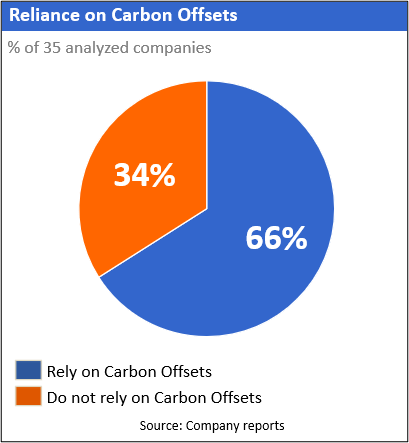
As shown in Figure 8, the majority of companies analyzed rely on offsetting to achieve their net-zero pledges. The analyzed mining and oil and gas companies have a particularly heavy reliance on offsets; all of them rely on carbon offsets to meet their net-zero targets. This, however, is no surprise, as hard-to-abate sectors, such as mining and oil and gas, will need to use offsetting to counteract their unavoidable future emissions in the coming years.
Whereas some companies adamantly believe in ‘high-quality credits’ that can play a key role in achieving net-zero emissions, other companies focus their efforts on emissions reductions rather than the purchasing of offsets (Box 1).
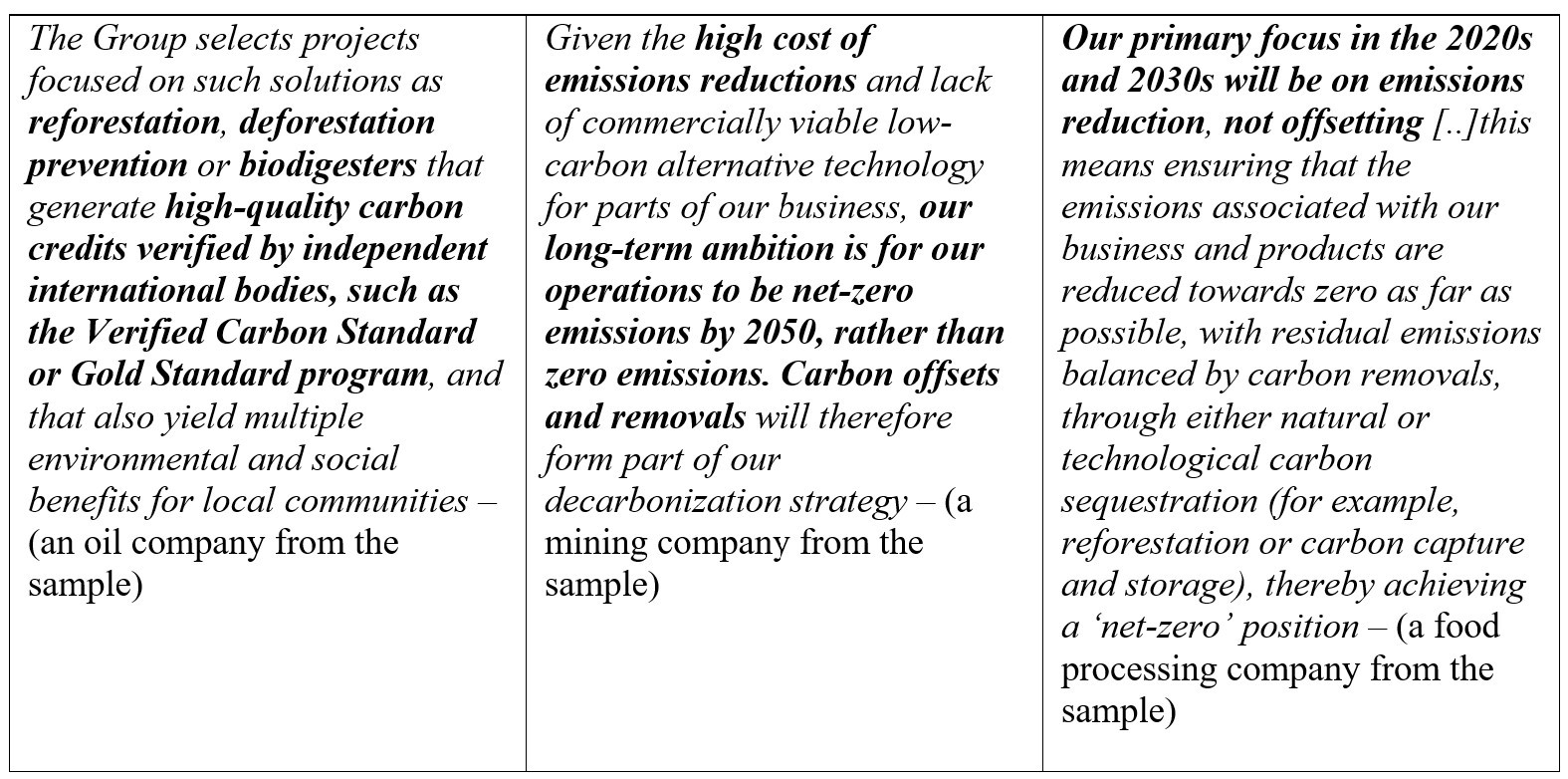
Much like carbon offsets, there is a strong reliance on CCS technologies to capture CO2 and store it in order to reduce the quantity of emissions that enter the atmosphere during industrial processes. The CCS process has three basic steps:
1) capturing CO2 during industrial processes;
2) compressing and transporting captured CO2;
3) storing/injecting compressed CO2 into rock formations for permanent storage,
Not surprisingly, this practice is more widespread in hard-to-abate sectors, such as cement and steel, which under all scenarios will have to rely on it for residual emissions. The problem is that CCS cannot be scaled in a timely manner to be relied on as a primary strategy, and most sectors other than the hard-to-abate ones can cost-effectively decarbonize without it. According to the International Energy Agency, as of April 2021, annual CO2 capture capacity from power and industrial facilities is 40 million metric tons. To give this number some perspective, Shell’s 2020 scope 1 emissions in 2020 were 98 million metric tons of CO2e and its scope 3 emissions in 2020 were 1304 million metric tons of CO2e. Thus, CCS would have to grow exponentially over the coming years if it is to seriously contribute to achieving net-zero targets by 2050. Much like carbon offsets, CCS allows companies to continue to burn fossil fuels and emit GHGs without credible plans to decarbonize.
Does the Company’s Governance Structure Incentivize Climate Action?
To incentive and catalyze climate action, companies need a governance structure that oversees and rewards setting and meeting robust, science-based decarbonization targets. For the most part, the companies analyzed have climate change oversight at the board level. In theory, the board of directors scrutinizes a company’s strategies on behalf of the shareholders. So, when shareholders are aligned with climate goals, climate oversight by the board of directors can provide an additional safeguard.

However, when it comes to the financial incentives for senior executives to meet climate targets, only some sectors engage in such practices, especially in the chemicals and utilities sectors. Cement, food processing, and steel sectors are the laggards.
Does the Company Have a Policy Not to Lobby Against Climate Change?
The final question this research answers is whether companies have a policy that requires their lobbying activities, either directly or through a trade association, to be aligned with Paris Agreement objectives. Direct lobbying entails any direct attempt on behalf of a company or organization to influence legislation. A trade association is generally a conglomeration of similar businesses that voice their members’ views on matters of common interest.
Company lobbying against climate policy and regulation, through direct lobbying and trade associations, has been a strong explanatory factor of our current climate crisis. At the same time as companies are publishing their net-zero pathways and claiming to advocate for systemic changes to combat climate change, their lobbying behavior—which causes tangible political and regulatory changes—still undermines policies that may catalyze the achievement of climate goals. Not surprisingly, figure 10 shows that most companies analyzed do not have Paris Agreement-aligned lobbying policies.
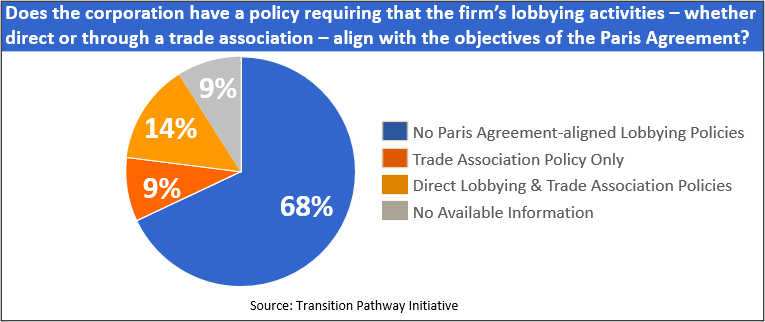
“We Need Maximum Ambition on All Fronts”
At COP26, the 26th UN climate change conference, UN Secretary-General António Guterres passionately exclaimed that “we need maximum ambition from all countries on all fronts.” For countries to achieve their commitments, regulation must drive the private sector to make and deliver on robust, science-based plans to decarbonize over the coming decades. As this research emphasizes, companies are doing too little across the board. From lacking short-term emissions reduction targets to actively lobbying against policies that would catalyze decarbonization, company pledges fall short of what is unequivocally needed to accelerate toward a decarbonized future.
For more information on corporate net-zero pledges, please see CCSI’s October, 2021 conference Corporate Alignment to the Paris Agreement: From Ambition to Action webpage, which includes recordings of the panels, links to presentations used, and a document with the conference’s top-ten takeaways.
The authors would like to thank Lisa E. Sachs and Martin Dietrich Brauch for their comments and additional support.

